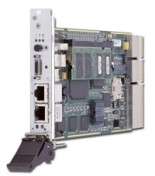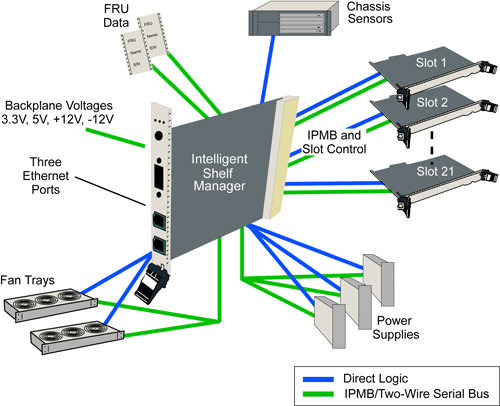CPC7301 Intelligent Shelf Manager
¤U¸üPDF
|
New!
NexusWare ISM is a Linux-based software suite and development environment
designed specifically for the CPC7301.
|
 Shelf
management ensures maximum service availability in a computing platform by
monitoring sensors and predicting failures. The CPC7301 Intelligent Shelf
Manager offers a comprehensive management architecture that delivers high
availability protection with reliable, redundant and IPMI (Intelligent Platform
Management Interface) standards-based management to all the major components in
the shelf, including the entire IPnexus™ product family.
Shelf
management ensures maximum service availability in a computing platform by
monitoring sensors and predicting failures. The CPC7301 Intelligent Shelf
Manager offers a comprehensive management architecture that delivers high
availability protection with reliable, redundant and IPMI (Intelligent Platform
Management Interface) standards-based management to all the major components in
the shelf, including the entire IPnexus™ product family.
The CPC7301 is a 3U, single-slot, Intelligent Shelf Manager (ISM) card for
all IPnexus platforms. It provides centralized management and alarming for
system power supplies, fan trays, fabric slots and node slots; including IPnexus
single board computers and I/O cards. The ISM may be paired with a redundant
standby ISM for use in high availability applications. A dedicated ISM-to-ISM
link allows redundant ISMs to synchronize management data and polling for
failover. The ISM provides comprehensive user and software interfaces via SNMP
(Simple Network Management Protocol), APIs (Application Programming Interface),
CLI (Command Line Interface), RMCP (Remote Management Control Protocol) and a
Web interface. The single slot, 6U, RTM4820 Rear Transition Module (RTM)
provides rear panel access to the I/O functions of two redundant CPC7301A ISMs.
Part of the Advanced Managed Platform offering, the CPC7301 provides hot-swap
slot control and monitoring of IPMI-based components in the chassis. When
thresholds (such as temperature and voltage) are crossed or a failure occurs,
the ISM captures these events, stores them in an event log, sends SNMP traps and
drives the telco alarm relays and alarm LEDs. User defined scripts and
applications allow OEMs to extend functionality directly into the ISM. The ISM
can query FRU information (such as serial number, model number, manufacture
date, etc.), detect presence of components (such as fan tray, CPU board etc.)
and perform health monitoring of each component. In addition, the ISM controls
the user-defined power-up sequencing of each slot via radial BD_SEL# signals.
Highlights
- Delivers High Availability
- Manages all IPMI-based components in platform
- Active/Standby dual ISM redundancy and synchronization
- Star topology provides enhanced reliability
- Out-of-band management with dedicated Ethernet interface
- Hot-swap support for field replaceable components
- System-Level Compatibility
- Compatible with IPnexus packet-based, IPMI-compliant products
- PICMG® 2.1, PICMG 2.9 and PICMG 2.16 compatible
- Comprehensive Software Interfaces
- NexusWare™ ISM development environment allows ISM customization and
addition of third-party applications
- SNMP, IPMI, RMCP, Telnet and SSH
- Command Line Interface (CLI)
- Web-based graphic user interface
- Comprehensive Hardware Interfaces
- Out-of-band Ethernet port
- Dedicated serial port
- µDB15 telco alarm interface with dry contact relays for critical, major,
minor & power fail
- Alarm cutoff pushbutton
- Critical, major, minor and hot-swap LEDs
- Flexible Design
- Complete single board computer with 600MHz CPU, memory, operating system
and peripherals
- Upgradeable memory
- Rear Transition Module
- Single-slot 6U RTM4820 module provides rear panel I/O access
- Interfaces (selectable front or rear)
Star Topology
In conjunction with the IPnexus platforms, the CPC7301 provides a
point-to-point IPMI connection from the ISM to each individual node or fabric
slot, to the power supply subsections and to the fan tray section in the chassis
- much like an Ethernet switch in a star topology. The ISM acts as the primary
Baseboard Management Controller (BMC) for the entire chassis, blocking any
traffic between two points of the star.
This protected architecture has two major benefits:
High Reliability
If any IPMI-based component or subsystem fails and renders its bus
inoperable, the ISM isolates it from the rest of the IPMI framework.
High Security
The ISM allows multiple single board computers with BMCs to coexist in the
same chassis but not compete as the primary management controller.

Comprehensive Management
The ISM manages up to 21 slots, which may be any combination of node slots
and fabric switch slots. In addition, it manages up to eight power supplies, up
to four fan trays and up to two redundant ISMs (itself and the standby ISM). It
can also access chassis sensors and a comprehensive list of management
information and configuration options provided by switched fabric components.
High Availability
The Intelligent Shelf Manager provides the ability to operate in redundant
mode, where one ISM is active and the other is in standby mode. In the event of
a failure on the active ISM, the standby ISM takes over control of the chassis.
A dedicated watchdog timer on each ISM monitors the software. In the event of a
software failure on the active ISM, the watchdog will initiate failover to the
standby ISM and reset the unstable ISM.
The configuration information, event log and other state information of the
active ISM is continuously synchronized with the standby ISM. This
synchronization can be performed via Ethernet switches in or out of the
platform, an Ethernet cable via front or rear panel or via a dedicated, internal
ISM-to-ISM Ethernet link to eliminate dependence on Ethernet switches and
external cabling.
The firmware on the ISMs can be updated remotely via the network in a secure,
fail-safe operation. This can be sequenced so that one ISM is active while the
other is being updated.
The ISMs are hot-swap capable for "always on" service and to reduce MTTR (Mean
Time To Repair).
Front Panel Input/Output
The Intelligent Shelf Manager’s front panel supports the following I/O (see
the RTM4820 datasheet for details on the Input/Output features for the ISM Rear
Transition Module):
- Out-of-band 10/100 Ethernet port provides access to SNMP, the Command Line
Interface (via Telnet or SHH), RMCP, FTP and the Web interface. It is also
used for sending network alerts
- In-band 10/100 Ethernet port via packet-switched backplane is also
supported
- Green link LED and amber activity LED
- µDB15-pin Telco alarm interface
- Dry contact relays indicate critical, major and minor events and
generate a continuous output until the alarm cut-off button is pressed or it
is turned off via software
- Dry contact relay indicates power fail
- Two optically isolated inputs allow clearing of major and minor alarms
- The relays and inputs are abstracted for future user-defined options
- RJ-45 COM port provides access to the Command Line Interface
- Minor, major and critical LEDs: three independent LEDs
- Hot-swap LED indicates ready to be hot removed
- Status LED indicates Active/Fault status
 NexusWare™
ISM NexusWare™
ISMNexusWare ISM is a development environment that allows
customers to add their own value and functionality to the CPC7301
Intelligent Shelf Manager (ISM). It leverages the flexible and scalable
architecture of the ISM, allowing customization of Linux kernel 2.4.18 and
ISM settings, addition of third-party applications and modification of ISM
management behavior. |
Warranty
One year
Specifications
CPC7301 supports the following specifications:
- PICMG 2.0 R3.0 (CompactPCI®) and PICMG 2.1 R2.0 (tot-swap) specifications
- PICMG 2.9 (CompactPCI system management)
- IPMI v1.5 intelligent platform management interface specification
- Compatible with PICMG 2.16 (packet-switched backplane)
- Designed for NEBS level 3 and ETSI installations
| Power Required |
| |
Min. |
Typ. |
Max. |
| Supply Voltage, VCC |
4.45V |
5.00V |
5.25V |
| Supply Current, VCC = 5.0V |
0mA |
— |
3A |
|
| Environmental |
The values below are stress ratings only. Do not operate the CPC7301 at
these max.:
Supply voltage, Vcc: 5V, ±5% with 50mV max ripple
Storage temperature: -40° to +85° C
Operating temperature: +5° to +55° C
Non-condensing relative humidity: <95% at 40° C |
| Operating Temperature |
The CPC7301 can operate between +5° and approx. +55° C ambient, with a
min. of 200LFM (1 meter per sec.) of external airflow. External airflow must
be provided to the CPC7301A at all times. |
| Operating System |
Linux Kernel version 2.4.18 |
I/O Interface
RS-232 Serial Port
10/100 Ethernet Port
Telco Alarm Port |
Connector Type
RJ-45
RJ-45
Micro-DB-15 |
|
| Telco Alarm Signal |
Alarm Relays
The CPC7301’s alarm relay circuits are capable of carrying 60V DC or 1A with
a max. rating of 30VA.
Opto Inputs
The CPC7301 accepts timed pulse inputs for clearing minor and major alarm
states (there is no reset for the critical state). Reset is accomplished by
asserting a voltage differential from 3.3V to 48V for between 200 and 300
ms. The acceptable voltage range is from 0 to 48V DC continuous. The current
drawn by a reset input does not exceed 12mA. |
Mechanical
|
In a compatible enclosure, the CPC7301 occupies a single 3U ISM slot.
Dimensions are below:
PCB dimensions: 100 mm x 160 mm x 1.6 mm
Board dimensions: 3U x 4HP (one slot)
Weight: 7.7 ounces |
| Regulatory Compliance (Pending) |
Safety
UL/cUL 60950 Safety for Information
UL File Number E179737
IEC 60950 Safety for Information Technology Equipment
CB Certificate and Report
CE Certificate
Emissions Tests Regulations
FCC, Class B
EN 55022/CISPR22 Class B Radiated and Conducted Emissions Tests
EN 55025/CISPER 24
EN-61000-3-2 Power Line Harmonic Emissions
EN-61000-3-3 Power Line Fluctuation and Flicker
EN-61000-4-2 Electro-Static Discharge (ESD)
EN-61000-4-3 Radiated Susceptibility
EN-61000-4-4 Electrical Fast Transient Burst
EN-61000-4-5 Power Line Surge
EN-61000-4-6 Frequency Magnetic Fields
EN-61000-4-11 Voltage Dips, Variation & Short Interruptions
Network Equipment-Building System - (NEBS) Requirements
GR-1089-CORE
Sect. 2 Electrical Discharge
Sect. 3.2.2 Radiated RF Emissions
Sect. 3.2.3 AC Line Conducted Emissions-Voltage
Sect. 3.2.4 AC & DC Line Conducted Emissions-Current
Sect. 3.3.1 RF Radiated Fields
Sect. 3.3.3 RF Common Mode
GR-63-CORE
Sect. 5.1.1.1 Low-Temperature Exposure & Thermal Shock
Sect. 5.1.1.2 High-Temperature Exposure & Thermal Shock
Sect. 5.1.1.3 High Relative Humidity Exposure
Sect. 5.3.1 Handling Drop Tests-Packaged Equipment
Sect. 5.3.2 Unpackaged Equipment Drop Tests
Sect. 5.4.1 Earthquake Tests
Sect. 5.4.2 Office Vibration Test Procedure
Sect. 5.4.3 Transportation Vibration-Packaged Equipment
Sect. 5.6 Acoustic Noise Test |
 Shelf
management ensures maximum service availability in a computing platform by
monitoring sensors and predicting failures. The CPC7301 Intelligent Shelf
Manager offers a comprehensive management architecture that delivers high
availability protection with reliable, redundant and IPMI (Intelligent Platform
Management Interface) standards-based management to all the major components in
the shelf, including the entire IPnexus™ product family.
Shelf
management ensures maximum service availability in a computing platform by
monitoring sensors and predicting failures. The CPC7301 Intelligent Shelf
Manager offers a comprehensive management architecture that delivers high
availability protection with reliable, redundant and IPMI (Intelligent Platform
Management Interface) standards-based management to all the major components in
the shelf, including the entire IPnexus™ product family.
 NexusWare™
ISM
NexusWare™
ISM